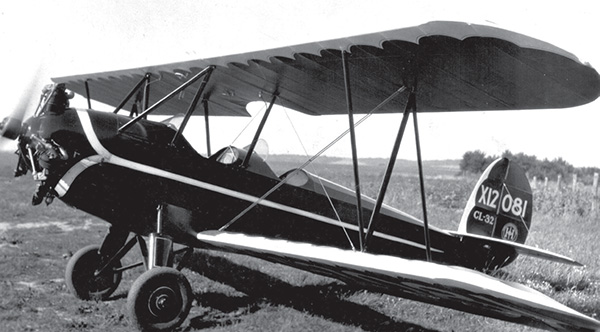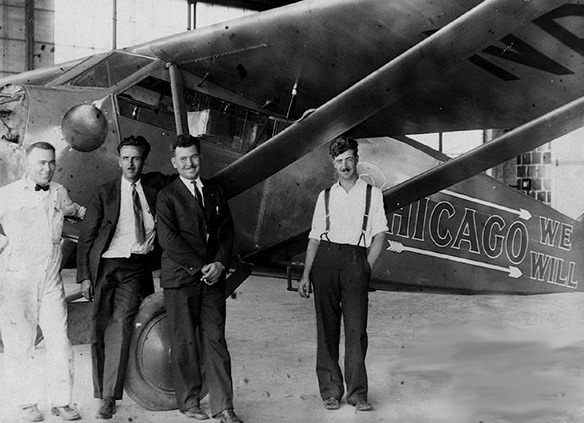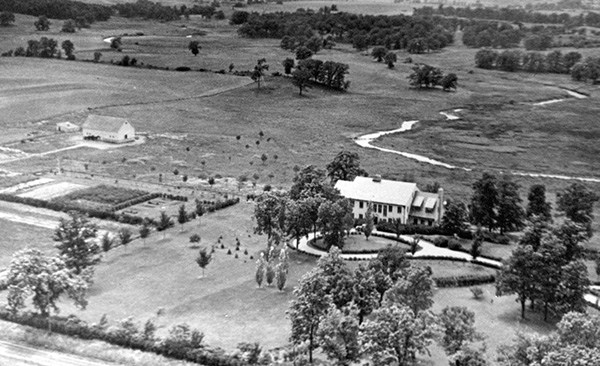Slipping the Bonds of Earth
Barrington’s Pioneer Aviator Wilson T. Herren Lived the Glory Days of Early Flight

Made in Barrington: In 1931, the Herren CL-32 is ready for flight from the Barrington countryside
From earliest civilization humans have soared in their imagination with the birds. The mechanics of their flight challenged enquiring minds. Leonardo da Vinci filled sketchbooks with concepts for flying machines which inspired generations to seek out lifting those sketches off the ground. The Wright Brothers, Henri Farman, Louis Bleriot, and others entered the 20th century inspired to slip the bonds of earth. Orville and Wilbur Wright experimented with gliders before they made the first powered flight at Kitty Hawk, North Carolina on December 17, 1903. The number of experimental aviators grew, especially in France.
But America remained ahead of the rest, culminating in May 1927 in the legendary solo trans-Atlantic flight of Charles Lindbergh, whose apprenticeship included flying the mail route between Chicago and St. Louis. “The Spirit of St. Louis”, Lindbergh’s Ryan monoplane, opened a highway between ground and sky, which men and women continue to explore, and a man from Barrington was among those early pioneers.

Kenneth Hunter makes mid-air repairs to the “City of Chicago”, formerly known as the “Chicago We Will” airplane.
Sky Harbor Airport, July 2, 1930
Thousands have been following the flight of the “City of Chicago” which had set out to break the endurance record for being refueled in mid-air set by the St. Louis’ Robin, and at this point the Stimson-Detroiter monoplane piloted by John and Kenneth Hunter. It had been in the air for over 520 hours. On Sunday, June 29 at 5:01 a.m., the City of Chicago had surpassed the Robin’s record. It was a triumph of determination, engineering, and risk-taking.
On the ground at Sky Harbor (now Chicago Executive Airport) a distinguished and thoughtful man is telling reporters that they hope to keep flying, refueling in midair until July Fourth. Wilson Herren is the promoter and manager of this endeavor. He is bringing a young lifetime of adventure and varied experiences to one of the challenges of this experimental aviation age—endurance flying. He has spent most of the last 10 days at the airport, and the reporters note sympathetically that he is showing signs of strain and weariness.

Wilson T. Herren (third from left) is joined by three of the four Hunter brothers
There have been mechanical problems, but all have been resolved and the plane has flown on, sometimes over Barrington, to indeed land on the Fourth of July; some estimates said there were 75,000 people watching, with radio stations and newspaper headlines proclaiming this latest success in the race to conquer the skies. The pilots received the public accolades, but it was the engineering and flying experience of Wilson Herren and his team on the ground that kept them flying.
An Adventurous Life
Wilson Teague Herren was born in 1892, in Chehalis, a town in the southwestern corner of Washington State, where his father, later Judge S.C. Herren, had gone to become an organizer of the Washington State Bar Association. In his teens, “Wilsie” began working at bridge construction in Washington State and Idaho. Intrigued by the increasing popularity of the automobile, he soon learned to take one apart and put it back together again. With his growing engineering capability, he entered as many speed tests as there were in the Northwest, and at the same time turned his attention to flying. He won his pilot’s license in 1913, one of the earliest on record.
Then he took off for Alaska, made some prospecting trips and did some big-game hunting. Fame was not his goal. He was ever-thoughtful and reserved, but the possibility of fortune beckoned. His success for the latter is not recorded, and flying had become his life. By 1916, he was doing aerial photography over Canada and Mexico. When America joined the First World War, Army recruiters, seeing his engineering experience, assigned him first to the 89th and then the 91st Infantry Divisions. He received distinguished service decorations on two fronts; from the Belgians and the French.
From Out West to the Barrington Area
From the trenches of unspeakable suffering, in peacetime he again sought the air. But first, there was a fateful move. His father joined a corporate law firm in Chicago, and his parents moved to Lake Zurich. Nearby Barrington offered a job as mechanical superintendent at the Standard Motor Company. He quickly became active in the community, especially with the American Legion. In 1919, he was one of the founding members of Post 158. Spencer Otis, Sr. was a charter member, and the first commander. Herren was the 1924 commander. This brought him community involvement, and one report was that his fellow Post members wanted to nominate him for village president.
Learning of Herren’s engineering experience, Otis made him superintendent of an industrial complex at the west end of Lake Street alongside the now CN Railway tracks. There Otis, one of the first estate owners, ran his National Boiler Washing Machine Company, and his Locomotive Terminals Improvement Company (LTI), both servicing companies for coal-fired steam locomotives. Herren oversaw the Otis operations for 12 years. In the mid-1920s, the diesel locomotive was gradually replacing the traditional steam locomotive, and the Boiler Washing Machine Company was becoming redundant. The same would happen with the Locomotive Terminal Company, but Herren had researched a method of lead-coating iron pipe to lengthen its life. This pipe was profitably sold to Wisconsin paper manufacturers and to the Northern Illinois Gas Company which used it until the 1960s.

Kenneth Hunter, (unknown woman), with Yvonne Hass Herren, Wilson Herren, and their son Robert.
In his early Barrington days, Wilson Herren married Yvonne Haas, whose family had been in the area since the late 19th century. They had four children, and some of their descendants remain in the Barrington area. In 1924, they built the house at 314 West Russell Street, creating the slight jog in the street to have a larger yard. A movie exists of two of his daughters playing Badminton on the spacious property. It was a good life in the Barrington of those years. It was a neighborly, social, and civic-minded community.
By the late 1920s, with aviation and its now celebrated flyers capturing the headlines, Herren was back in the air. First, at the LTI plant, he built a bi-plane, designed around the Wright J-5, for Major Merrill D. Mann, then president of Continental Airlines. This was the model for a plane that flew the mail from Chicago to New Orleans for several years. But Herren was drawn to the experimental concept of refueling in flight. Towards the end of the ‘20s, a record 320 hours of midair flight had been met at St. Louis. Herren became determined to bring this record back to Chicago.
On August 1, 1929, with co-pilots Russell Mossman of Barrington, and C.E. Steele, a Pan Am pilot from Detroit, Herren took up a test flight from Municipal Airport (now Midway) and learned enough to continue with further tests. Mossman and Steele went up again, but the flight was ended by magneto trouble, unfixable in the air. Herren also experimented with in-air refueling at the small airstrip on the Buckley property in Barrington Hills. But his goal was to break that St. Louis record, which resulted in the Hunter Brothers historic flight ending so triumphantly on the Fourth of July in 1930.
Barrington Takes Flight
But after that? His focus moved him closer to home. The sprawling brick buildings on James Street were built in the First World War. The best-known tenant of later years was the Barrington Courier Review, formerly the Barrington Review. Through the early pages of that newspaper, before it came to James Street, we learn that the building was used as an aircraft factory. The Barrington Review of May 28, 1931 carried the headline “Airplane Factory May Come to Barrington”. It announced the formation of the Herren Aeronautical Corporation by Barrington men for the purpose of manufacturing light aircraft. Wilson Herren was joined in the endeavor by William Beckman, and other unnamed partners.
By June 4, the newspaper reported that the factory site would be announced the following week, although the James Street building had already been leased. The June 18 Review said that work had started on the first aircraft there, and it was hoped to have three test airplanes under construction in early July and in the air before the end of August. Herren, speaking directly with the newspaper, said that his company proposed to manufacture a flying unit which would answer the present demand in aeronautics. He said that while aviation had progressed steadily since the war, the private use of airplanes for pleasure vehicles was limited by the fact that previously no light, safe, inexpensive planes had been manufactured.
Hereafter, the Review was reporting almost weekly on progress at the factory, with precise details of the bi-plane’s construction. The first successful flight was made at Sky Harbor Airport on January 7, 1932. The pilot was George Fischer, manager of the airport. He took off in 25 feet and flew round the airport for 15 minutes. Upon landing, he declared the plane marvelous. He said it was “A flivver of the air”. That it “rose rapidly, flew fast and landed like a feather”.

In 1925, Charles W. Buckley and his son, Robert W. Buckley, left the North Shore to build this country estate in what is today’s Barrington Hills. Later named Brookmoor Farm, the farm’s large acreage had a grassy landing strip for small aircraft. In the 1970s, small planes and a hot air balloon took off from this property. PHOTO COURTESY OF DAVID BUCKLEY, SR.
On February 11, an electric bulb line dropping from the ceiling at the James Street plant caused a fire that destroyed three wings of the plane. Herren and his engineers recovered from the fire to build a new plane. The second plane had successful test flights out of Elgin Airport with local man William Klingenberg, Jr. as the pilot (learn more in our back-page essay). His verdict that “the plane practically flies itself” was reported enthusiastically in the Review on July 20, 1932. He had taken the plane through many maneuvers, including flying around over Barrington, and was optimistic about its future. Chiang Kai–Chek, a politician and military leader who served as the leader of the Republic of China from 1928 and on, contracted for 1,000 of these planes. But he ran out of money and that fell through, about the same time that the Great Depression brought about bank closures. Financing dried up and the Herren plant was forced into receivership and closed.
Temporarily, Wilson Herren returned to one of his early interests, prospecting. He and his family briefly left Barrington for Reno, Nevada, where he joined a placer mining operation at the behest of a friend, as a member of the Board of Directors. Returning to Barrington, he joined the Henry Pratt Company, one of Chicago’s oldest and most successful engineering companies where he became a vice president. He flew a Cessna, often for company inspection trips. In 1942, he registered for Selective Service, in the Fourth Registration. Often called the “Old Man’s Draft”, it registered men who were 45- to 64-years-old at the time.
Yvonne Haas Herren died in 1965, and Wilson in 1971. They are buried in Evergreen Cemetery with a simple headstone. But Wilson Herren has an epitaph where it would have pleased him most. His daughter Jane Lund entered her father’s name on the Wall of Honor at the Smithsonian’s National Air and Space Museum, permanently recording his place in the advancement of flight. The location is Foil: 11 Panel. 4 Column: Line 48. And it all began in Barrington almost 90 years ago.
